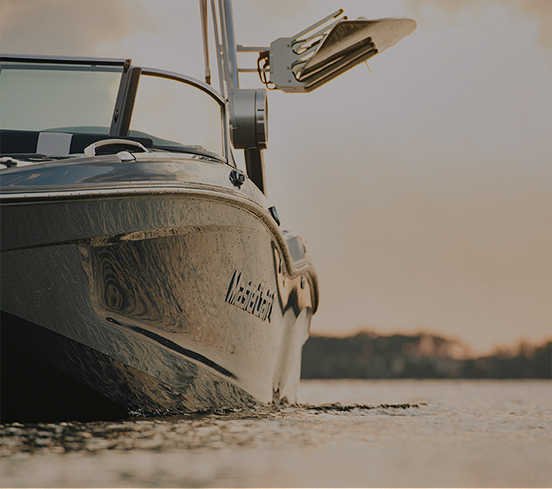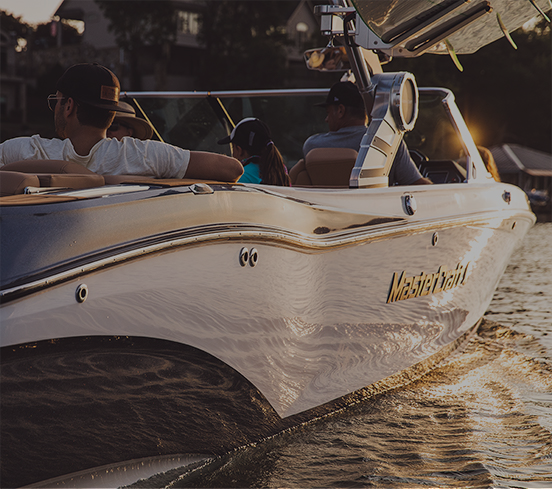STARTING & BASIC OPERATIONS
Before Starting:
Always familiarize yourself with the controls and indicators used in your boat. Perform all Safety Checks and Services and ensure that all Scheduled Maintenance Checks and Services are up to date.
Before each use perform a prelaunch inspection:
Step 1:
Lift the engine cover and inspect the bilge and engine compartment for any fluid/vapor leakage.
Step 2:
Check the hull drain plugs. Make sure they are installed and secure.
Step 3:
Operate the bilge blower for at least four (4) minutes. Leave the bilge blower ON through the starting process and until the boat is on plane.
Starting the Engine:
Attach the emergency engine safety switch tether (lanyard) to an article of your clothing and to the switch.
All models will have a removable ignition key. Its purpose is for safety and security. The key should be inserted prior to starting an outing, and removed at the conclusion. This is intended to prevent theft or unapproved use of the boat.
To start the boat:
Insert the key and turn. This turns ON the electrical system and prompts the battery(ies) to provide power to accessories and the engine START-STOP button.
Momentarily press the ENGINE START-STOP button to fire the engine.
NOTE: While the engine is warming up, check to see that all lights, video screens and gauges operate properly. Check that the steering system operates freely.
Shifting Gears:
When shifting gears, always move the control lever smoothly and quickly into gear. Do not hesitate. Slow gear engagement could damage the shifting mechanism in the transmission.
NOTE: When shifting from forward to reverse or reverse to forward, be sure to stop the control lever in the neutral position and allow the engine to fall between 600-800 RPM before completing the shift.
A one-hand, single-lever control operates as both a gear shifter and a throttle. The lever automatically locks in the neutral position (straight up and down) for safety. The lever can be moved from neutral only by raising the umbrella lifter under the throttle knob. Shifting is accomplished by moving the lever forward or backward. Center (straight up) is neutral. Moving the lever forward engages the running gear; moving it back from center puts the drive train into reverse. Never attempt to shift without the engine running! This causes excessive wear to the shifting mechanism and may negatively affect control of the boat.
During regular warm-up of the engine, it is possible to temporarily increase the engine RPMs without moving the boat. To accomplish this, push in the button located at the bottom of the shift/throttle lever with one hand and pull up the ?umbrella? (umbrella lifter under the throttle knob). Move the lever to desired position and then simultaneously release the button and umbrella. The engine will run with increased RPMs and can be increased or decreased by moving the lever. Returning the handle to the neutral position will bring the system back to neutral and reduce the engine RPMs to preset levels. This function should be done sparingly. Over-revving the engine for any extended period can cause undue wear and tear on the engine. Avoid advancing to wide-open-throttle and holding the RPMs at that level.
Under Way:
If the oil pressure gauge indicates low or no oil pressure, immediately stop the boat and check the oil level. If the temperature gauge indicates overheating, stop the boat when it is safe to do so and check the raw water system for blockage. DO NOT operate the boat until the cause for the warning has been found and corrected.
Stopping:
Step 1:
Slowly bring the control lever to the neutral position. If the boat has been driven for a long period of time or at high speed, allow the engine a two-to-three (2-3) minute cool-down period at low idle (600-800 RPM).
Step 2:
Press the ENGINE START-STOP button.
Step 3:
At the conclusion of the outing, turn the key off and remove from the key slot. Turn the battery switch to ?Off?. Doing so will ensure that you have turned OFF the electrical system, and prevent others people from starting or running the boat.
Step 4:
If any problems were encountered during operation, have the boat inspected by an authorized MasterCraft dealer. Request any necessary repairs before resuming operation of the boat.

